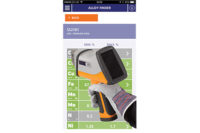Electroless Nickel (EN) plating is an advanced plating process, where a nickel-phosphorous alloy is deposited onto a metal or plastic substrate as a result of a controlled chemical reaction. This plating process is often preferred for certain applications because of the resulting mechanical properties, stability and brightness of the plating. The EN plating process is an autocatalytic process, where the nickel alloy layer is deposited onto a metallic or non-metallic surface without the use of an electrical current or without use of an external electrical power supply.
TECH TIPSNew developments in microspot XRF allow for coating thickness and composition measurement of EN plating on automotive, aerospace and PCB components. Microspot XRF, as for all XRF methods, is considered nondestructive and assists quality control managers to maintain chemistry, and control plating. Incorporating XRF into a quality control program can improve efficiencies, save cost, and most importantly, minimize risks of product recalls |
During this chemical reaction the metal being deposited onto a work piece is immersed in an aqueous solution referred to as a bath. The reducing agent within the bath, typically sodium hypophosphite, releases hydrogen which reacts with metal ions to produce a negative surface charge which results in deposition of the nickel alloy onto the substrate. This type of plating is recognized for its reliable, repeatable coating of uniform thickness which in some cases can eliminate the need for post-plate grinding.
Other characteristics seen as a benefit of the EN process are that it provides superior corrosion protection, lubrication, solderability and wear resistance. It is for this reason that EN has widely been adopted within the automotive, aerospace and military industries as well as the printed circuit board industry which also serves these industries with the need for high-reliability electronics.
Electroless nickel coatings are typically categorized into three phosphorus concentration ranges associated with specific metallurgical properties: low (2-5%), mid (6-9%) and high (10-13%). For instance, low phosphorous electroless nickel is recognized for its uniform thickness inside and outside of complex configurations and often eliminates the need for grinding after plating, whereas high phosphorous electroless nickel offers superior ductility and corrosion resistance for more demanding applications. Electroless nickel can be applied to a multitude of base materials including: aluminum, titanium, mild, stainless and hardened steels, copper, brass and die-cast zinc.
Electroless nickel plating was introduced over 50 years ago as a means to provide lightweight materials for improved fuel efficiencies, greater corrosion performance and durability. It is for this reason that EN was quickly implemented into the automotive, aerospace and transportation industries plus it is seen as an alternative to plating with chrome because of its ability to meet many engineering requirements while complying with environmental legislations. Directives specific to End of Life Vehicle (ELV), Restriction of Hazardous Substances (RoHS), Environmental Protection Agency (EPA), and the Occupational Safety and Health Administration (OSHA) pushed chemistry suppliers to increase research and development toward engineering alternatives to chrome technology due to environmental and health concerns brought on by high-toxicity for both air and water associated with the use of chrome within the manufacturing process. Today EN has become a viable alternative to improve energy efficiency, address engineering requirements and to reduce the amount of hazardous waste introduced into the environment.
Electroless Nickel Applications in Automotive and Aerospace
EN applications have been widely accepted in today’s automotive industry for parts such as: gear assemblies, bearings, fuel injection systems, aluminum fuel filters, break pins and valve bleeds and likewise in the aerospace industry for protection of rotating parts and shafts. Another significant advantage of EN and why it is beneficial to the aerospace and automotive industries is because of its ability to produce deposits in uniform thickness even if the piece has complex shapes and geometries by ensuring that sharp edges, deep recesses and blind holes can be plated to uniform thickness. However, it is still important to note that uniformity for EN can sometimes vary on edges, threads, small holes or deep recesses. In some cases this method of plating can eliminate the need for industrial lubricants for components and parts. EN processes are becoming more and more popular in these industries and it continues to be adopted as a process into new industries outside of these markets for industries such as electronics, chemicals and petroleum, railroad, printing, textiles, wood, paper and much more.
Electroless Nickel Applications in Electronics
Electroless nickel-immersion gold (ENIG) and electroless nickel-electroless palladium-immersion gold (ENEPIG) are both applied to printed circuit boards (PCB) to protect the nickel from oxidation, necessary to ensuring quality for high reliability electronics within the automotive, aerospace and military industries. The primary function of ENIG and ENEPIG is to provide a solderable surface finish with distinct bonding characteristics that will ultimately produce a circuit board that has an extensive shelf life and is suitable for all surface mount and through-hole assembly applications. For quality assurance reasons it is required to be able to check the phosphorus content underneath a thin gold layer or the stack of gold and palladium layers. For either of these printed circuit board applications, it is desirable for testing to be performed without the use of chemical assay or the need to cross section the printed circuit board after the plating process is completed, avoiding the destruction of the piece.
Microspot X-Ray Fluorescence (XRF) for Quality Control and Screening of a Plating Process
X-ray fluorescence is an analytical technique where a primary beam of X-rays bombards a sample with enough energy to eject electrons from their stable orbits within an atom, leaving an unstable vacancy. An electron from a higher energy state spontaneously slows down to occupy the vacancy, resulting in the emission of a secondary X-ray. This secondary X-ray has a discrete energy that is characteristic to each element and the specific transitions that occurred. By identifying the energy of the secondary X-rays it is possible to determine which elements are present in the sample. Counting the number of secondary X-rays enables the XRF instrument to determine the amount (thickness and composition) of each element present in the sample.
XRF instruments have been employed widely for many years to determine elemental composition and coating thickness, and are becoming increasingly specialized to address more demanding analytical requirements. Microspot XRF instruments—systems designed to measure small features and samples by reducing a large primary X-ray beam down to the micrometer scale—were once restricted to measuring relatively simple applications with a limited number of elements or layers, minimal or no spectral overlaps, and only capable of detecting elements with high atomic mass such as potassium. Now, these systems are evolving to measure more complex applications with many more elements or alloys, layers and greater coverage of the periodic table. This type of XRF is an ideal testing method because it provides a nondestructive measurement of thickness and composition and takes only seconds to obtain accurate, repeatable and real-time analysis without the use of chemicals or purge gases.
XRF is an accepted standard by the American Society for Metals (ASM), the Association Connecting Electronic Industries (IPC), American Society for Nondestructive Testing (ASNT), and the Society of Manufacturing Engineers (SME) to name a few. XRF serves as a catalyst for engineers devoted to quality control/assurance standards to measure coating thickness at any stage of the plating process from incoming inspection to final quality check. Use of XRF analysis throughout the plating process can provide benefits such as cost optimization, conformation of compliance to standards and it also helps to guarantee smooth functionality and longevity of the finished assembly or product. Most importantly, XRF analysis can assist manufacturers to avoid costly recalls of components and product, and it can save a company from irreparable harm in the face of product failures.
New Advances in XRF Provide Nondestructive, Real-Time Measurement of NiP
New advances in microspot XRF technology such as high-definition Silicon Drift Detectors (SDD) have made it possible to measure both nickel and phosphorous content directly under air path allowing for both the coating thickness and chemical composition to be determined simultaneously.
To ensure the highest level of accuracy in measuring nickel phosphorous (NiP) with microspot XRF it is important to choose a microspot unit that has a suitable tube/detector combination and optimized the geometry design (minimized distance between sample and detector) which is the key driver to allow for the accurate and direct measurement of Phosphorous content and coating thickness of the NIP layer.
Microspot XRF is a key means to provide critical coating thickness analysis for the quality control throughout the EN process because it can help to provide a precise measurement of the deposition when the desired outcome is to produce an alloy of nickel and phosphorus in varying ratios. In this instance, XRF can ensure that the desired characteristic is achieved. Since the physical and chemical properties of EN are crucially dependent on the underlying Phosphorus content (%P) it is of great importance to confirm the correct phosphorous concentration range to ensure a homogeneous coating thickness distribution and restrict the phosphorous content accordingly.
Phosphorous is an element that has a relatively low X-ray energy (K-alpha: 2.01 keV), and in NiP compound coatings the “depth of analysis” for phosphorous is typically less than 2 microns. Therefore, only the higher energy Ni X-ray signal (K-alpha: 7.47 keV) is used for coating thickness determination. In the determination of chemical composition of the nickel phosphorus plating one can recourse to the phosphorous X-ray fluorescence line directly. The determination of chemical composition of NiP compound is based on direct observation of the phosphorous X-ray fluorescence line.
Conclusion
New developments in microspot XRF allow for coating thickness and composition measurement of EN plating on automotive, aerospace and PCB components. Microspot XRF as for all XRF methods, is considered nondestructive and assists quality control managers to maintain chemistry, and control plating. Incorporating XRF into a quality control program can assist to monitor production processes during all phases of the plating process and to assist to improve efficiencies, save cost, and most importantly to minimize risks of product recalls by ensuring that products are plated to specifications such as: AMS-2404, AMS-C-26074, ASTM B-733, ASTM B-656 and MIL-DTL-32119, IPC-4556 (a new standard) and ASTM-B568. Coating thickness platers whose roles are focused on quality control and assurance and who incorporate XRF in their process to measure the coating thickness of EN plating are able to produce rapid, accurate and repeatable results.
In addition, with a global emphasis on the reduction of lead and chrome within today’s manufacturing processes and with the ultimate goal to reduce the impact of hazardous materials on the environment, use of XRF can conversely ensure proper disposal for electronics and End of Life Vehicles (ELV) as well as to provide valuable qualitative and quantitative analysis, to determine in the recycling process whether or not a lead or chrome alloy was used in the manufactured process of the discarded electronic or mechanical component. It also may be surprising to find that XRF can be used to recover gold from electronic scrap.




